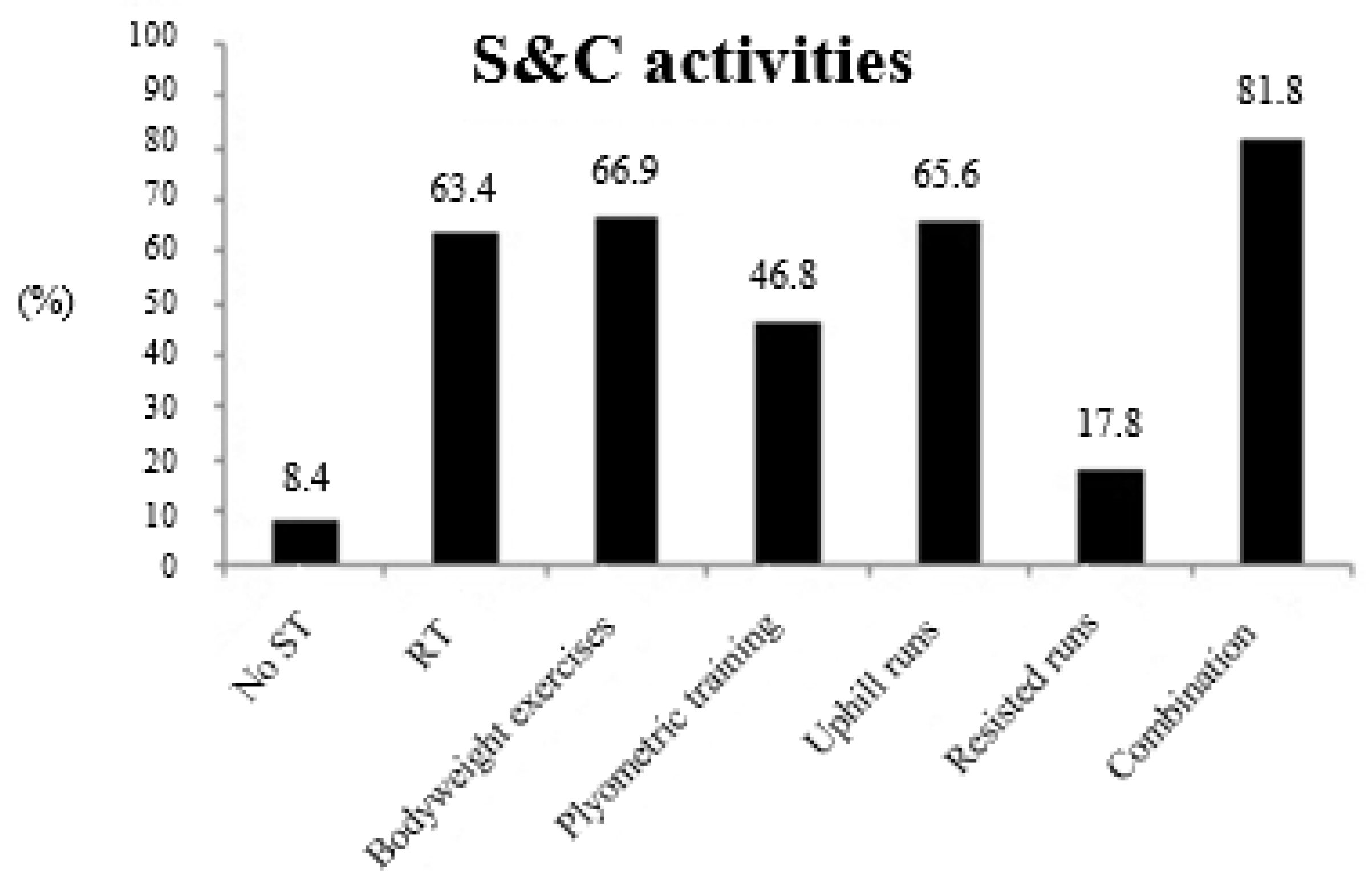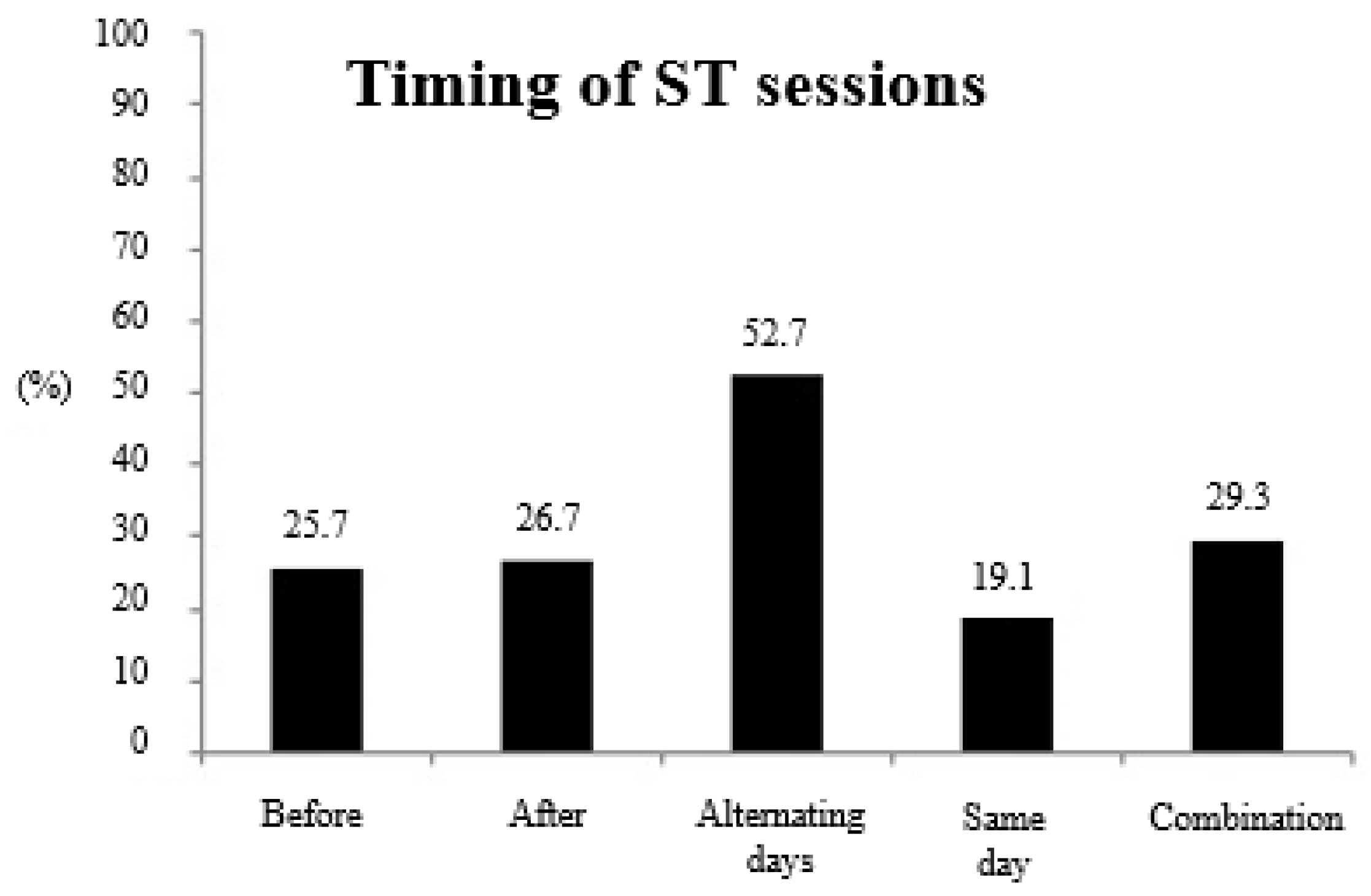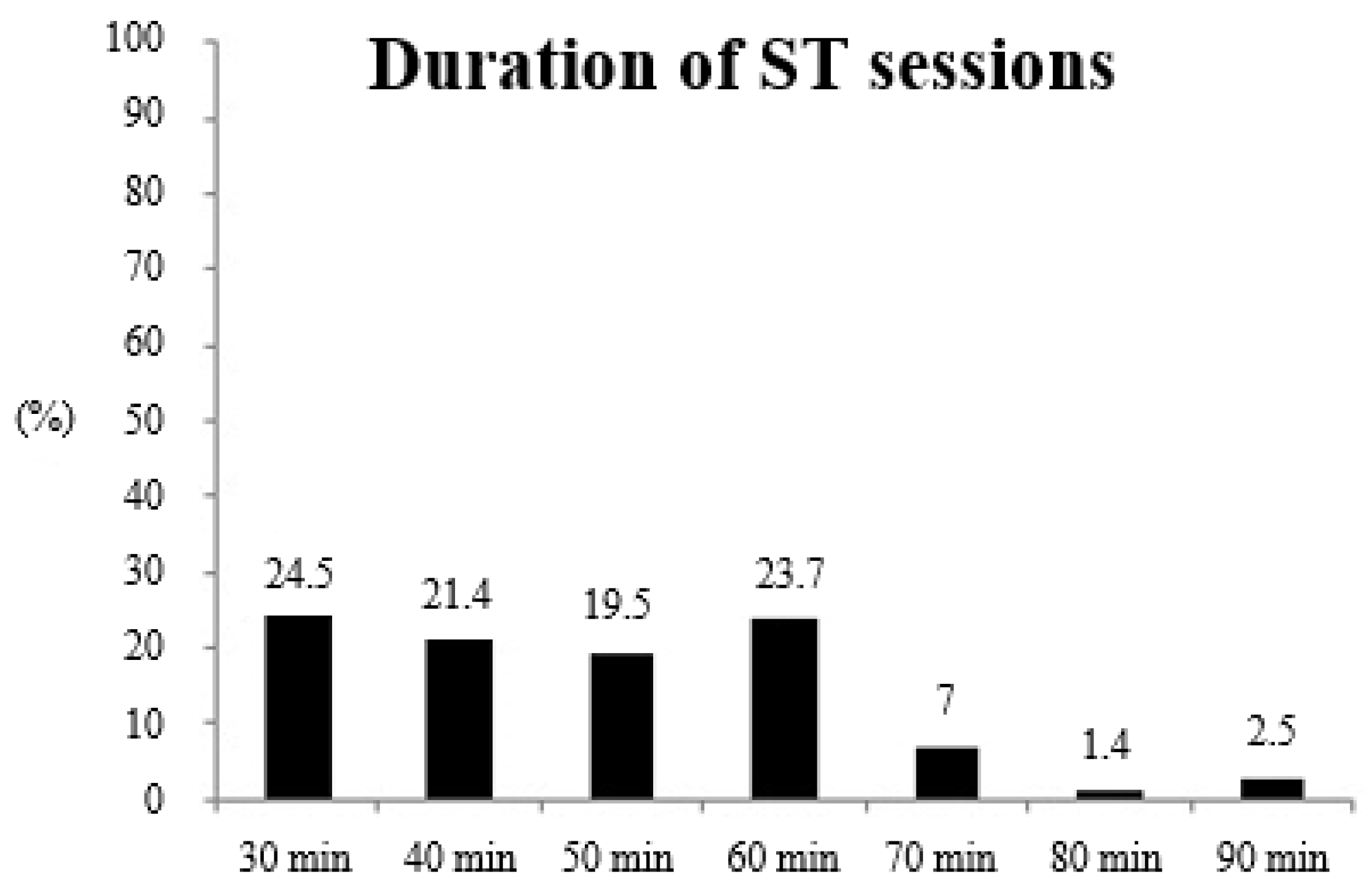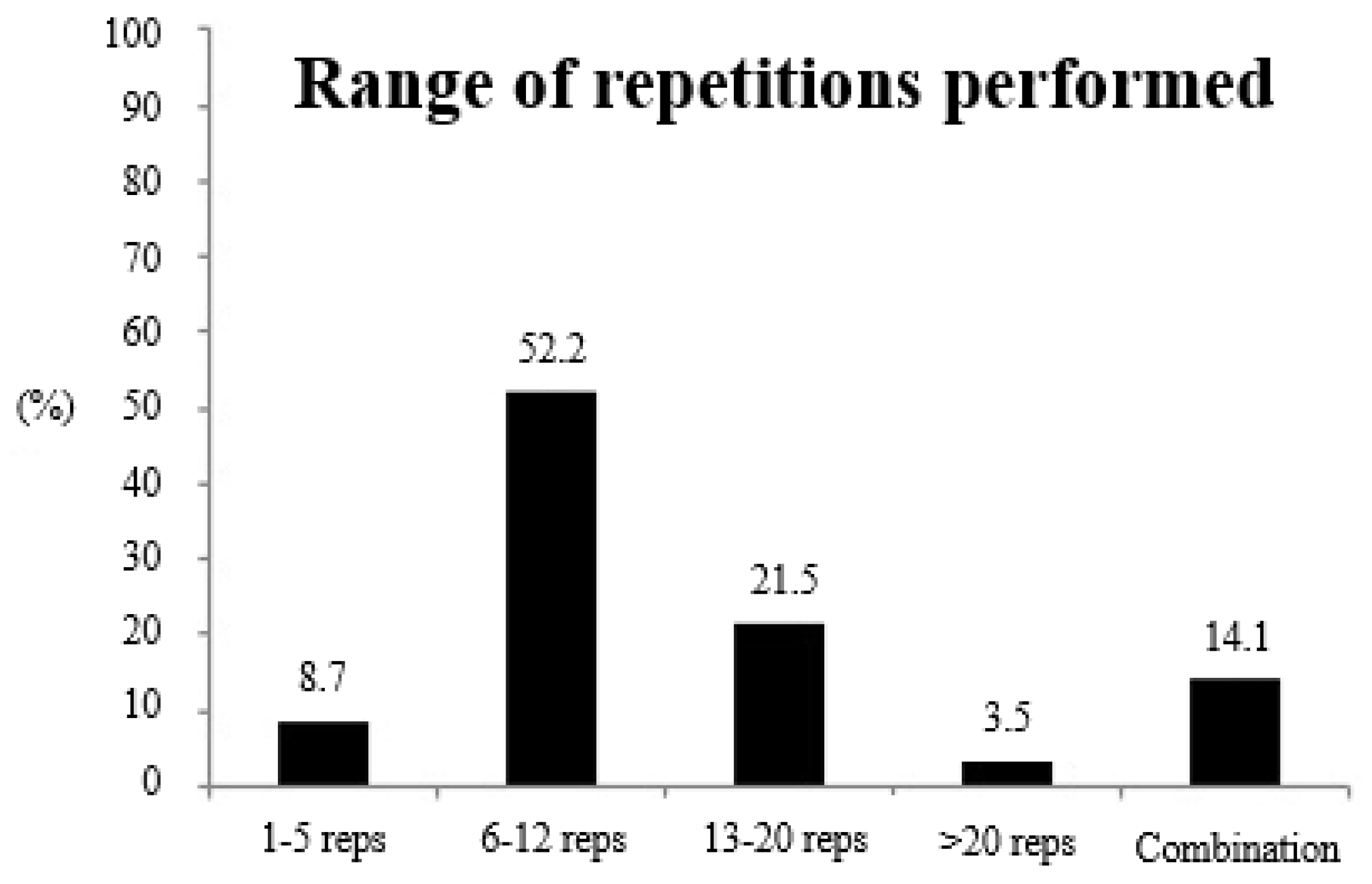Strength Training Habits in Amateur Endurance Runners in Spain: Influence of Athletic Level
Abstract
1. Introduction
2. Materials and Methods
2.1. Participants
2.2. Procedures
- (i)
- Demographic information (i.e., sex and age).
- (ii)
- Information about athletic performance in the last 6 months, including whether the athletes had a coach (through a yes/no question), whether they were a registered athlete (through a yes/no question), and their personal best in a 10-km trial (through nominal scale including different durations ranging from 50–55 min to <30 min).
- (iii)
- Information about their training programs in the last 6 months, including hours and kilometers per week (through nominal scales, e.g., 2–3 h and 30–35 km), perceived importance of ST (through Likert-type scale, 1–3 rating, in which 1 means “ST is perceived as not important” and 3 means “ST is perceived as very important” in their training programs), ST sessions per week (ranging from 0 to 14 sessions per week), duration (ranging from 0 to 180 min per session), type (through nominal scales, including “no ST sessions”, “ST with external load”, “bodyweight exercises”, “plyometric training”, “hill runs”, and/or “resisted runs”), and timing of ST sessions (through nominal scales, including “no ST sessions”, “just before running exercises, same day”, “just after running exercises, same day”, “same day, but at least 4–5 h between running and ST”, and/or “alternating days to running workouts”), range of repetitions per set performed (ranging from 0 to >20), incorporation of core training (through a yes/no question), foot muscles training (through a yes/no question), respiratory muscles training (through a yes/no question).
2.3. Statistical Analysis
3. Results
4. Discussion
5. Conclusions
Author Contributions
Funding
Acknowledgments
Conflicts of Interest
References
- Van Dyck, D.; Cardon, G.; de Bourdeaudhuij, I.; de Ridder, L.; Willem, A. Who Participates in Running Events? Socio-Demographic Characteristics, Psychosocial Factors and Barriers as Correlates of Non-Participation—A Pilot Study in Belgium. Int. J. Environ. Res. Public Health 2017, 14, 1315. [Google Scholar] [CrossRef]
- Scheerder, J.; Breedveld, K.; Borgers, J. Who Is Doing a Run with the Running Boom? The Growth and Governance of One of Europe’s Most Popular Sport Activities. In Running across Europe: The Rise and Size of One of the Largest Sport Markets; Palgrave Macmillan: London, UK, 2015. [Google Scholar] [CrossRef]
- Videbæk, S.; Bueno, A.M.; Nielsen, R.O.; Rasmussen, S. Incidence of Running-Related Injuries Per 1000 h of Running in Different Types of Runners: A Systematic Review and Meta-Analysis. Sports Med. 2015, 45, 1017–1026. [Google Scholar] [CrossRef] [PubMed]
- Nielsen, R.Ø.; Parner, E.T.; Nohr, E.A.; Sørensen, H.; Lind, M.; Rasmussen, S. Excessive Progression in Weekly Running Distance and Risk of Running-Related Injuries: An Association Which Varies According to Type of Injury. J. Orthop. Sport. Phys. Ther. 2014, 44, 739–747. [Google Scholar] [CrossRef]
- Nielsen, R.O.; Buist, I.; Sørensen, H.; Lind, M.; Rasmussen, S. Training Errors and Running Related Injuries: A Systematic Review. Int. J. Sports Phys. Ther. 2012, 7, 58–75. [Google Scholar] [PubMed]
- Van der Worp, M.P.; ten Haaf, D.S.M.; van Cingel, R.; de Wijer, A.; Nijhuis-van der Sanden, M.W.G.; Staal, J.B. Injuries in Runners: A Systematic Review on Risk Factors and Sex Differences. PLoS ONE 2015, 10, e0114937. [Google Scholar] [CrossRef]
- Bertelsen, M.L.; Hulme, A.; Petersen, J.; Brund, R.K.; Sørensen, H.; Finch, C.F.; Parner, E.T.; Nielsen, R.O. A Framework for the Etiology of Running-Related Injuries. Scand. J. Med. Sci. Sports 2017, 27, 1170–1180. [Google Scholar] [CrossRef]
- Lauersen, J.B.; Bertelsen, D.M.; Andersen, L.B. The Effectiveness of Exercise Interventions to Prevent Sports Injuries: A Systematic Review and Meta-Analysis of Randomised Controlled Trials. Br. J. Sports Med. 2014, 48, 871–877. [Google Scholar] [CrossRef]
- Beattie, K.; Kenny, I.C.; Lyons, M.; Carson, B.P. The Effect of Strength Training on Performance in Endurance Athletes. Sports Med. 2014, 44, 845–865. [Google Scholar] [CrossRef] [PubMed]
- Balsalobre-Fernández, C.; Santos-Concejero, J.; Grivas, G.V. The Effects of Strength Training on Running Economy in Highly Trained Runners: A Systematic Review with Meta-Analysis of Controlled Trials. J. Strength Cond. Res. 2015, 30, 2361–2368. [Google Scholar] [CrossRef]
- Yamamoto, L.M.; Lopez, R.M.; Klau, J.F.; Casa, D.J.; Kraemer, W.J.; Maresh, C.M. The Effects of Resistance Training on Endurance Distance Running Performance among Highly Trained Runners: A Systematic Review. J. Strength Cond. Res. 2008, 22, 2036–2044. [Google Scholar] [CrossRef]
- Berryman, N.; Maurel, D.; Bosquet, L. Effect of Plyometric vs. Dynamic Weight Training on the Energy Cost of Running. J. Strength Cond. Res. 2010, 24, 1818–1825. [Google Scholar] [CrossRef]
- Esteve-Lanao, J.; San Juan, A.F.; Earnest, C.P.; Foster, C.; Lucia, A. How Do Endurance Runners Actually Train? Relationship with Competition Performance. Med. Sci. Sports Exerc. 2005, 37, 496–504. [Google Scholar]
- García-Pinillos, F.; Ramírez-Campillo, R.; Roche-Seruendo, L.E.; Soto-Hermoso, V.M.; Latorre-Román, P.Á. How Do Recreational Endurance Runners Warm-up and Cool-down? A Descriptive Study on the Use of Continuous Runs. Int. J. Perform. Anal. Sport 2019, 19, 102–109. [Google Scholar] [CrossRef]
- Karp, J.R. Training Characteristics of Qualifiers for the U.S. Olympic Marathon Trials. Int. J. Sports Physiol. Perform. 2007, 2, 72–92. [Google Scholar] [CrossRef]
- Blagrove, R.C.; Brown, N.; Howatson, G.; Hayes, P.R. Strength and Conditioning Habits of Competitive Distance Runners. J. Strength Cond. Res. 2017, 34, 1392–1399. [Google Scholar] [CrossRef]
- Griffin, C.; Egan, B.; Blake, C.; Horgan, P. Training Trends and Injury Incidences among Irish Distance Runners. Br. J. Sports Med. 2017, 51, 324–325. [Google Scholar] [CrossRef]
- Rønnestad, B.R.; Mujika, I. Optimizing Strength Training for Running and Cycling Endurance Performance: A Review. Scand. J. Med. Sci. Sports 2013, 24, 603–612. [Google Scholar]
- Gottschall, J.S.; Hastings, B. An Integrated Core Training Program Improves Joint Symmetry and Metabolic Economy in Trained Runners. J. Sports Med. Phys. Fitness 2019, 59, 2003–2008. [Google Scholar] [CrossRef] [PubMed]
- Cheung, R.T.H.; Sze, L.K.Y.; Mok, N.W.; Ng, G.Y.F. Intrinsic Foot Muscle Volume in Experienced Runners with and without Chronic Plantar Fasciitis. J. Sci. Med. Sport 2016, 19, 713–715. [Google Scholar] [CrossRef]
- Matias, A.B.; Taddei, U.T.; Duarte, M.; Sacco, I.C.N. Protocol for Evaluating the Effects of a Therapeutic Foot Exercise Program on Injury Incidence, Foot Functionality and Biomechanics in Long-Distance Runners: A Randomized Controlled Trial. BMC Musculoskelet. Disord. 2016, 17, 1–9. [Google Scholar] [CrossRef]
- Tong, T.K.; McConnell, A.K.; Lin, H.; Nie, J.; Zhang, H.; Wang, J. “Functional” Inspiratory and Core Muscle Training Enhances Running Performance and Economy. J. Strength Cond. Res. 2016, 30, 2942–2951. [Google Scholar] [CrossRef]
- Romaratezabala, E.; Castillo, D.; Raya-González, J.; Rodríguez-Negro, J.; Aritzeta, I.; Yanci, J. Health and Wellness Status Perception of Half-Marathon Runners: Influence of Age, Sex, Injury, and Training with Qualified Staff. Int. J. Environ. Res. Public Health 2020, 17, 5649. [Google Scholar] [CrossRef]





| Variables | Strength and Conditioning | LG (n = 72) | LG2 (n = 126) | LG3 (n = 237) | LG4 (n = 324) | LG5 (n = 192) | p-Value |
|---|---|---|---|---|---|---|---|
| Strength and conditioning activities | No ST | 14 (19.4) b,c,d,e | 18 (14.3) a,d,e | 30 (12.7) a,d,e | 21 (6.5) a,b,c,e | 6 (3.1) a,b,c,d | <0.001 |
| RT | 41 (56.9) d,e | 66 (52.3) c,d,e | 147 (62.1) b,d,e | 219 (67.5) a,b,c,e | 140 (73.0) a,b,c,d | ||
| BW | 36 (50.0) b,c,d,e | 89 (70.6) a | 157 (66.2) a | 223 (68.9) a | 140 (72.9) a | ||
| PT | 20 (27.7) b,c,d,e | 60 (47.6) a,c,d,e | 94 (39.7) a,b,d,e | 173 (53.3) a,b,c,e | 112 (58.3) a,b,c,d | ||
| Uphill runs | 33 (45.8) b,c,d,e | 81 (64.2) a,d | 157 (66.2) a,d | 233 (71.9) a,b | 129 (67.2) a | ||
| Resisted runs | 12 (16.7) c,e | 20 (15.8) c,e | 25 (10.5) a,b,e | 43 (13.2) e | 63 (32.8) a,b,c,d | ||
| Combination | 44 (61.1) b,c,d,e | 98 (77.8) a,c,d | 173 (72.9) a,b,d,e | 158 (48.8) a,b,c,e | 152 (79.2) a,c,d | ||
| Core | Yes | 60 (83.3) b,c,d,e | 112 (88.9) a,e | 214 (90.3) a,e | 293 (90.4) a,e | 181 (94.3) a,b,c,d | 0.061 |
| No | 12 (16.7) | 14 (11.1) | 23 (9.7) | 31 (9.6) | 11 (5.7) | ||
| Intrinsic foot muscles | Yes | 17 (23.7) b,c,d,e | 41 (32.5) a,c,d,e | 64 (27.2) a,b,d,e | 148 (45.6) a,b,c,e | 80 (41.8) a,b,c,d | <0.001 |
| No | 55 (76.3) | 85 (67.5) | 173 (72.8) | 176 (54.4) | 112 (58.2) | ||
| Respiratory muscles | Yes | 7 (9.8) b,c,d,e | 25 (19.8) a,c,d,e | 37 (15.7) a,b,d,e | 82 (25.4) a,b,c,e | 66 (34.3) a,b,c,d | <0.001 |
| No | 65 (90.2) | 101 (80.2) | 200 (84.3) | 242 (74.6) | 126 (65.7) |
| Variables | Strength and Conditioning | LG1 (n = 60) | LG2 (n = 69) | LG3 (n = 72) | LG4 (n = 18) | LG5 (n = 9) | p-Value |
|---|---|---|---|---|---|---|---|
| Strength and conditioning activities | No ST | 12 (20) b,c,d,e | 7 (10.1) a,c | 3 (4.2) a,b,d,e | 2 (11.1) a,c | 1 (11.1) a,c | 0.010 |
| RT | 24 (40) b,c,d,e | 35 (50.7) a,d,e | 44 (61.1) a,d,e | 12 (66.6) a,b,c,e | 7 (77.8) a,b,c,d | ||
| BW | 20 (33.3) b,c,d,e | 33 (47.8) a,c,d,e | 39 (54.2) a,b,d,e | 11 (61.1) a,b,c,e | 6 (66.7) a,b,c,d | ||
| PT | 20 (33.3) b,c,d,e | 28 (40.6) a,c,d,e | 35 (48.6) a,b,d,e | 6 (55.5) a,b,c,e | 8 (88.9) a,b,c,d | ||
| Uphill runs | 23 (38.3) b,c,d,e | 36 (52.2) a,c,d,e | 39 (54.2) a,b,e | 12 (66.7) a,b,e | 7 (77.8) a,b,c,d | ||
| Resisted runs | 0 (0) c,d,e | 3 (4.3) c,d,e | 5 (6.9) a,d,e | 5 (27.8) a,b,c,e | 5 (55.6) a,b,c,d | ||
| Combination | 24 (40) b,c,d,e | 41 (59.4) a,c,d,e | 49 (68.0) a,b,e | 13 (72.2) a,b,e | 8 (88.9) a,b,c,d | ||
| Core | Yes | 50 (83.3) b,c,d,e | 61 (88.4) a,c,d,e | 69 (95.8) a,b,d,e | 17 (94.4) a,b,c,e | 8 (88.9) a,b,c,d | 0.004 |
| No | 10 (16.5) | 8 (11.6) | 3 (4.2) | 1 (5.6) | 1 (11.1) | ||
| Intrinsic foot muscles | Yes | 20 (33.3) | 21 (30.4) | 21 (29.2) | 9 (50) | 6 (66.7) | 0.837 |
| No | 40 (66.7) | 48 (69.6) | 51 (70.8) | 9 (50) | 3 (33.3) | ||
| Respiratory muscles | Yes | 8 (13.3) | 13 (18.8) | 20 (27.8) | 9 (50) | 7 (77.7) | 0.200 |
| No | 52 (86.7) | 56 (81.2) | 52 (72.2) | 9 (50) | 2 (22.3) |
Publisher’s Note: MDPI stays neutral with regard to jurisdictional claims in published maps and institutional affiliations. |
© 2020 by the authors. Licensee MDPI, Basel, Switzerland. This article is an open access article distributed under the terms and conditions of the Creative Commons Attribution (CC BY) license (http://creativecommons.org/licenses/by/4.0/).
Share and Cite
García-Pinillos, F.; Lago-Fuentes, C.; Jaén-Carrillo, D.; Bujalance-Moreno, P.; Latorre-Román, P.Á.; Roche-Seruendo, L.E.; Ramirez-Campillo, R. Strength Training Habits in Amateur Endurance Runners in Spain: Influence of Athletic Level. Int. J. Environ. Res. Public Health 2020, 17, 8184. https://doi.org/10.3390/ijerph17218184
García-Pinillos F, Lago-Fuentes C, Jaén-Carrillo D, Bujalance-Moreno P, Latorre-Román PÁ, Roche-Seruendo LE, Ramirez-Campillo R. Strength Training Habits in Amateur Endurance Runners in Spain: Influence of Athletic Level. International Journal of Environmental Research and Public Health. 2020; 17(21):8184. https://doi.org/10.3390/ijerph17218184
Chicago/Turabian StyleGarcía-Pinillos, Felipe, Carlos Lago-Fuentes, Diego Jaén-Carrillo, Pascual Bujalance-Moreno, Pedro Ángel Latorre-Román, Luis Enrique Roche-Seruendo, and Rodrigo Ramirez-Campillo. 2020. "Strength Training Habits in Amateur Endurance Runners in Spain: Influence of Athletic Level" International Journal of Environmental Research and Public Health 17, no. 21: 8184. https://doi.org/10.3390/ijerph17218184
APA StyleGarcía-Pinillos, F., Lago-Fuentes, C., Jaén-Carrillo, D., Bujalance-Moreno, P., Latorre-Román, P. Á., Roche-Seruendo, L. E., & Ramirez-Campillo, R. (2020). Strength Training Habits in Amateur Endurance Runners in Spain: Influence of Athletic Level. International Journal of Environmental Research and Public Health, 17(21), 8184. https://doi.org/10.3390/ijerph17218184









